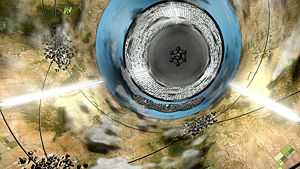Rama (spacecraft)
Rama is a fictional mysterious extraterrestrial vessel that is the subject and setting of the science fiction novel Rendezvous with Rama by Arthur C. Clarke, and the later sequel trilogy by Clarke and Gentry Lee: Rama II, Garden of Rama, and Rama Revealed. It exists in a fictional future timeline of Earth. In the books Rama is described by Clarke as essentially a dark, featureless metallic cylinder distinguished by its size: 54 km long and 20 km in diameter. If the cylinder were unfolded, its internal area would be 50 km long and 50 km wide, giving a surface area of 2500 km2. The cylinder is described as being mostly hollow and, when rotating around its long axis, creates the illusion of gravity on the inner surface of the shell in the style of an O'Neill cylinder. The characters experience the Coriolis effect at various points in the novel when objects are not in contact with the hull. Rama is, for all intents and purposes, an artificial world, with a usable landscape, capable of supporting human life. It belongs to the science-fiction class of Big Dumb Objects.
Rendezvous with Rama (Phase I)
Name and discovery
In the story, Rama is first encountered by humans in the year 2131, when it enters the solar system at a speed and heading that will take it on a 'slingshot' course around the sun and back out into deep space. It is initially mistaken for a giant asteroid when first detected by Spaceguard, an automated radar net designed to warn Earth of potential impact threats. Its first designation is therefore a database code: "31/439", according to the year (2131 CE) and its order of discovery. As it travels closer to perihelion, it comes to the attention of humans due to its anomalous shape and heading. Still believing it to be an asteroid, astronomers give 31/439 a proper name due to its size. Following the tradition of naming celestial objects after mythological figures, 31/439 becomes "Rama", after the Hindu deity; Clarke explains that by this time, all the names of Greek and Roman mythological figures have been used up.

After much speculation over the following months, telescope observation and unmanned probes confirm that Rama is an artificial construct, and therefore (albeit indirectly) Earth's first contact with extraterrestrial life. The Rama vessel is intercepted and explored by the crew of the nearest human space vessel, the Solar Survey ship Endeavour, under Commander William Norton. Endeavour intercepts Rama, Norton and his team explore the ship, and depart after a three-week mission. Rama, apparently indifferent to the life forms it has encountered, refuels using the matter and energy collected from the sun, executes several minor course corrections, and leaves the solar system.
Statistics
| Exterior/Overall | Interior | |
| Length | ~54 km | ~50 km |
| Diameter | ~20 km | ~16 km |
| Surface Area | ~4000 km2 | ~2500 km2 |
| Volume | ~17000 km3 | ~10000 km3 |
| Mass | ~1016 kg | |
(The distances are approximate, since they appear to vary throughout the book.)
- Propulsion. Rama's maximum acceleration is 0.02 g, or 0.1962 m/s² when the Cylindrical Sea is liquid, and when it is frozen, in excess of 10g, or 100 m/s², such as to attain relativistic speeds quickly, using an unknown form of reactionless drive, which seems to operate by generating a field around Rama that negates the inertia of the mass that it captures. Nearby vessels are deflected when it operates. Whatever the nature of its engineering, Rama could freely control its velocity, rotation and heading.
- Power. Rama can refuel by absorbing energy and material en masse directly from a star. When travelling between stars without voyagers, virtually all of its systems and mechanics are shut down, and it effectively becomes a dead relic; its temperature reaches nearly absolute zero. If it has voyagers aboard, it keeps Rama's interior above the melting point of the Cylindrical Sea.
- Defense. Passive. Rama's hull, except around the Cylindrical Sea and the North Pole (see below), is at least 2 km thick, and composed of an unidentified alloy that could withstand direct radiation from Sol up to a radius of 5 million km. Rama I's hull is completely solid according to seismic tests; Rama II's hull is crisscrossed with a maze of tunnels, rooms, and halls. Rama could also create a bubble of perfectly reflective material around itself, in which it passed through the sun's chromosphere unharmed. Also, a mesh-like type of "cocoon", when deployed around Rama, is able to negate the effect of nuclear weapons which were fired at it in Rama II
- Offense. Rama has no hostile capability of any kind.
Design
Most of the following names and terms were chosen arbitrarily by the crew of the Endeavour.
The fore end of Rama's axis, in the direction of its acceleration, is called North. The aft end is South. These points make up the navigational system used inside Rama.
- North Pole: The bow of Rama is designed around three airlocks.
- South Pole: The stern of Rama is where the engines are located.
- The Cylindrical Sea: An artificial body of water that divides Rama's internal space between northern and southern hemicylinders.
- New York: A mysterious clustering of tall buildings on an island in the middle of the Cylindrical Sea.
- The Horns: A regular grouping of spires at the South Pole, within Rama. Exactly at the Pole is a single large spire dubbed the "Big Horn", and arranged in a hexagonal pattern around this are six other spires (aka "Little Horns"), each shorter and with a smaller diameter. The Horns seem to be used in Rama's enigmatic system of propulsion.